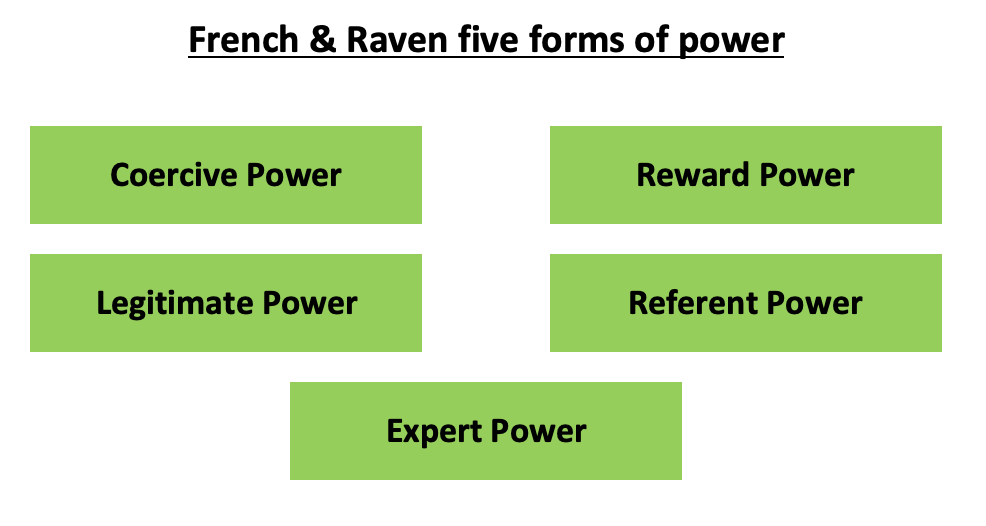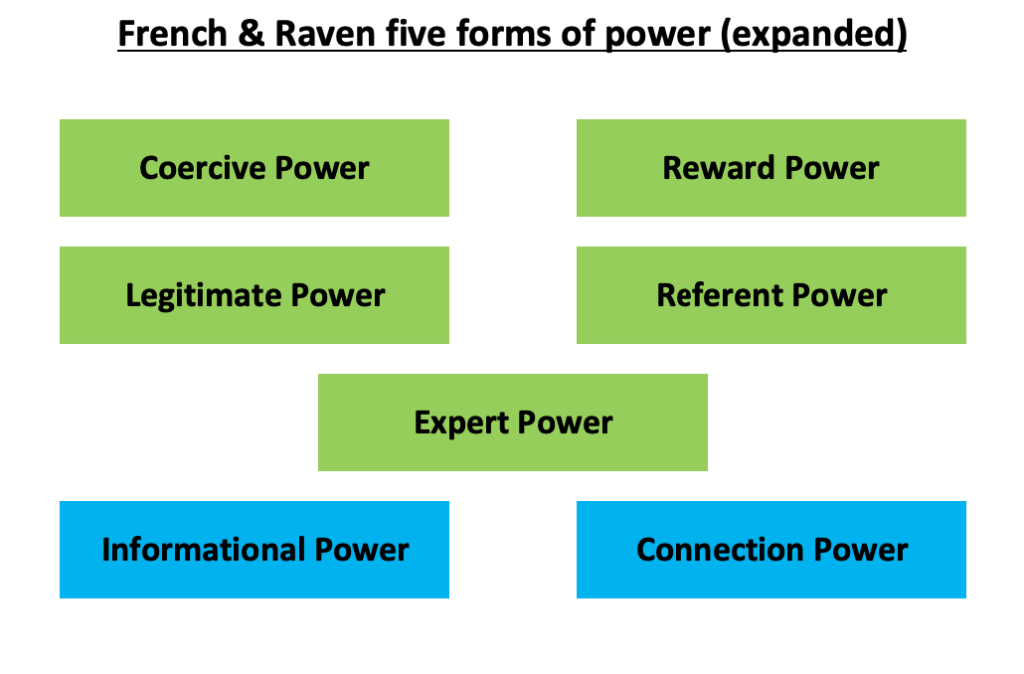
For many of us, power and leadership go hand in hand. Having a theory that informs how power originates from within the workplace can provide leaders with a significant opportunity of being successful in their role.
In today’s article, we’ll be studying such a model by taking a look at French and Raven’s five forms of power theory.
In the article, we’ll be looking at:
- What is the Five Forms of Power theory
- What is power in Leadership
- Who Were French and Raven?
- The five Forms of Power
- 1 – Coercive Power
- 2 – Reward Power
- 3 – Legitimate Power
- 4 – Referent Power
- 5- Expert Power
- The Seven Forms of Power
- 6 – Informational power
- 7 – Connection power
- Benefits of Five Forms of Power
- Criticism of Five Forms of Power
What is the Five Forms of Power theory?
The five forms of power theory was developed by
Bertram Herbert Raven & John R. P. French.
The theory evidences how power presents itself in five different forms and has important implications within Human Resource Management.
Each style has a series of attributes with positive and negative aspects associated with them.
The five forms of power has become a hugely popular and widely used business theory that can help us understand the linkages between power and leadership.
What is power in Leadership?
Power within leadership can come in a variety of forms, including:
- The ability to hire & fire people
- The ability to affect rewards (like pay)
- The ability to demonstrate subject matter expertise
- The ability to attract a “tribe” (i.e. a group of people that look up to an individual).
- The ability to ‘control’ an organization through the setting of goals and targets
Who Were French and Raven?
John R. P. French was an American psychologist and professor. He graduated from Antioch College and received his doctorate from Harvard University. He was an expert in social psychology and experimental research. He was widely published and was a recipient of the National Institute for Mental Health’s Research Career Award and a Fulbright Fellowship.
Bertram Raven was an American Academic. He was a member of the psychology department at UCLA and visiting professor and lecturer at several universities, including, amongst them, the University of Hawaii, the University of Nijmege in the Netherlands.
The Five Forms of Power

French and Raven’s concept presents five different forms of power, which are as follows:
1. Coercive Power
As the name indicates, this kind of power is founded on coercion. The kind of leader who uses coercive power leads with threat, intimidation, and force. The main objective of this kind of power is to gain compliance. However, it often leads to issues.
In many cases, coercive power is abused and can lead to toxic behavior. When you win your employees’ respect through coercion, i.e., the use of force in one way or another, you won’t be able to keep their respect for long and you will definitely lose their loyalty.
2. Reward Power
People in positions of power are able to give out rewards in the form of raises, bonuses, promotions, good assignments, training opportunities, and even in the form of praise, encouragement, and compliments. This type of power makes use of rewards to encourage positive results, so it’s based on the idea that people are more motivated and inclined to do things well when they know they’re getting something they value in return.
The problem with reward power is that when the reward is not perceived as valuable enough or you are not able to influence the giving of rewards, you lose traction.
3. Legitimate Power
Legitimate power is power that presidents, prime ministers, monarchs, CEOs, religious ministers, etc., have. It refers to the ability certain leaders have to link feelings of obligation or responsibility to their management and they make use of reward and punishment.
This form of power is based on a role, a title, a position, and it depends on that to remain effective. So, as long as you hold the title, you’re able to use your legitimate power.
However, the influence wielded by this form of power is limited to what people determine you have a right to control, and once the position is lost, power is lost also.
4. Referent Power
Referent power is the form of power you gain when someone likes you, respects you, and approves of you. Leaders that have this form of power are perceived as role models, and it’s also the kind of power that celebrities or influencers have. This form of power is viewed with admiration and it emanates from someone who’s liked and relatable.
However, this kind of power is a big responsibility and it can be easily abused. Not to mention it can change if the person does something to lose people’s respect or admiration. On its own, referent power is not the best strategy, but in combination with other forms of power, such as expert power, it can be extremely useful.
5. Expert Power
Last but not least, we have expert power, which is gained when you have the knowledge and skills that allow you to have a deep understanding of a situation. It’s based on expertise and these kinds of leaders are considered to be highly intelligent, demonstrate amazing performance and experts on a certain subject or several.
Because their expertise is respected and appreciated, leaders with this kind of power can persuade employees to do things for them very easily. That’s because they’ve gained true respect and trust.
Seven forms of power
More recently, the theory has been expanded with the addition of two further styles of power:

6. Informational power
The ability to control the information that other people need to achieve something. This form of power isn’t truly influential or effective when it comes to building credibility because it’s difficult to hold this kind of power for too long. Eventually, releasing the information will be necessary.
7. Connection power
Influence is obtained by being acquainted or gaining favor with someone who’s powerful. In other words, it’s focused on networking. This is the kind of power that’s held by the people who have a natural ability to connect with others and build relationships.
Benefits of Five Forms of Power
As with all models and theories, there are both benefits and criticisms that are levied.
The benefits associated with the Five forms of power are:
- It’s a simple concept that is easy to understand
- It helps provide people with a clear concept of the many forms power can take
- It demonstrates clear demarcations between styles
- It allows people to recognize these forms of power and avoid being influenced by people with less effective types of power.
Criticism of Five Forms of Power
- While the theory demonstrates the ability to influence, there is no obligation of individuals to accept influence
- People may be influenced by the same leader in different ways and react differently to particular styles (i.e some maybe reward driven others not)
- The theory does not account for an organizational design where multiple leaders with different styles may be in play at the same time
- Assumes all those being influenced have the same access to and information from the particular leader in question
Summary
French and Raven’s five powers theory is an important and widely used concept.
How does the relate to power within your organizaiton? Are you able to categorize your leaders into the five (or seven) buckets? Does it help explain how people manage?
As ever we’d love your input and feedback, you can reach out to us on Twitter or use the comments section at the foot of the article.
This article is part of our Human Resources guide.